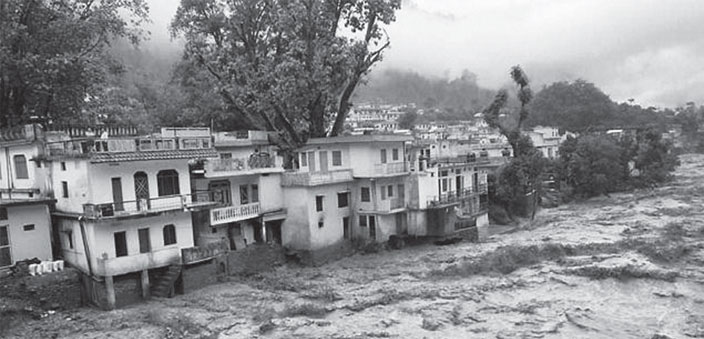THE Uttarakhand disaster in 2013 has exposed many serious infirmities of the state and the central governments. Complete lack of disaster management and responsive administration is obvious, both at the state and the central level, possibly with the exception of military forces that went all out to save lives during the disaster. Lack of any consideration of Uttarakhand’s disaster vulnerability in its development policies, plans and projects is also apparent. Lack of preparedness for such climate change induced events can also be clearly seen.
The Union Ministry of Environment and Forests (MoEF) must take a big share of the blame for having completely failed to ensure any credible environmental governance. The Expert Appraisal Committee (EAC) on River Valley Projects (it appraises hydropower and dam projects for environment clearances) that it has selected had almost zero rejection rate for seven years. The EAC and MoEF have refused to take action for poor and dishonest environmental impact assessments. There is an absence of any credible public hearing process, absence of any proper cumulative impact assessment, absence of any carrying capacity and complete lack of any environmental compliance mechanism or repeated non-compliance. The ministry itself has no capacity, will or even willingness to ensure compliance of norms and environmental management plans. Even when evidence of stark violations has been presented, the ministry has refused to take any credible action. The MoEF’s EIA notification excludes large number of projects and it has refused to correct this serious anomaly inspite of numerous representations. This misgovernance has largely been responsible for the Uttarakhand disaster, and is likely to invite more disasters across the Himalayas.
Partners in crime
Government of India’s premier technical water resources agency, namely the Central Water Commission is in charge of flood forecasting, but that agency completely failed in making any forecasts of the Uttarakhand floods. Now to cover up its failure, it is indulging in misleading propaganda that the Tehri dam saved the downstream areas, which is completely wrong considering the available river flow information for Bhagirathi, Alaknanda and Ganga. In whole of the worst affected Rudraprayag district, there is just one rain gauge, indicating how poor our basic weather monitoring system is. India’s premier space agency, Indian Space Research Organisation (ISRO) is supposed to have latest satellite based monitoring system, but that also did not provide any inputs during the disaster that could have helped reduce the scale of damages.
Equally apparent is the complete lack of integration of the climate change concerns in the governance of the state. India has been taking pride internationally for its National Action Plan on Climate Change (NAPCC), formulated in 2009 without any participatory process. It was formulated under guidance of the prime minister’s 26 member Council on Climate Change (PMCCC), which was constituted in 2008. More than halfway through the implementation period (2009- 2017) of the action plan, we find that there is no impact of the work of the PMCCC or the NAPCC on the functioning of one of the most climate vulnerable states.
Disasters that hit Uttarakhand before
Everyone seemed completely surprised and unprepared for what struck Uttarakhand, even though climate scientists have been warning of exactly such events. Even if the current event is unprecedented in timing, scale of devastation and spread of affected area, several similar events happened in the same state over the last few years. In 2012 alone there were two monsoon related disasters in Uttarkashi and Rudraprayag; the same areas also took the hit this year. Eight such disasters have struck Rudraprayag over the last 34 years. Scientists have also been warning that a large earthquake is imminent in both eastern and western Himalayas. The Uttarakhand Disaster Mitigation and Management Centre has prepared reports on both the disasters of 2012, but the recommendations of both the reports remain unimplemented.
Vulnerabilities of Uttarakhand are largely applicable to all Himalayan states from Jammu & Kashmir to Arunachal Pradesh. Many observers are calling the current Uttarakhand disaster as Himalayan Tsunami. Tsunami may be a misnomer here in many respects, since Tsunami is a natural phenomenon, whereas the Uttarakhand disaster is significantly contributed by human actions and inactions. However, by that very metaphor, we connect the fate of all Himalayan states.
The Union Ministry of Environment and Forests’ ‘4X4 Climate Assessment Report’ of 2010 has identified the Himalayan region as one of the four most vulnerable areas. This region covers 533,000 sq km or 16.2 percent of the total geographical area of the country, spread over 12 states. Being the youngest and the loftiest mountain, the report says the region is most unstable and fragile. Sixty five percent of the geographical area of this region is under designated forests but “with few exceptions, most of this forest has been cut” says the report. That march of deforestation has actually accelerated in recent years, including under the NAPCC era.
Some of the obvious lessons from this disaster are listed here:
- Put in place credible system of early warning, forecasting and dissemination for all kinds of disasters in public domain, with access for everyone.
- Put in place a monitoring system that will give prompt report of actual rainfall so that the downstream administration can be alerted.
- Policies and mechanisms for protection and conservation of rivers, riverbeds, catchments and flood plains, including aquatic biodiversity. Do not allow encroachment of riverbeds and floodplains. Remove all illegal encroachments on river beds and flood plains in a time bound manner.
- Do not allow unsustainable mining of riverbeds, blasting for any development activity as blasting increases landslide potential in landslide vulnerable area like Uttarakhand.
- Ensure credible environmental and social impact assessment of all activities including all dams and hydropower projects above 1 MW capacity, such assessments should include how the projects can increase the disaster potential, how they will affect the adaptation capacity in the context of climate change.
- Ensure credible environmental compliance mechanism for each project in which local people have a key role.
- No projects should be cleared until there is credible cumulative impact assessment including carrying capacity study for all projects in the river basin/sub basin. An urgent review of under construction and under planning projects should be taken up.
- Certain rivers, forests and high risk zones should be declared as no project areas in each basin.
- All states must have an active state disaster management authority with key role in development decisions.
- We need clearly defined disaster and regulatory mechanisms in place for what is to be done before, during and after the disaster.
- All EACs should have a disaster management specialist and all EIAs and CIAs should have disaster management plans and assessment as to how the project will change the vulnerabilities of the area.
Hydropower projects have increased disaster risk
There is little doubt that existing and under construction hydropower projects of Uttarakhand played significant role in increasing the proportion of disaster1. Many of us wrote to the Union Ministry of Environment and Forests in early July 2013 to investigate this and to fix responsibility and learn necessary lessons. The MoEF did not respond to the letter. However, in what turned out to be the most significant and hopeful post disaster event, the Supreme Court bench of Justice K S Radhakrishnan and Dipak Misra, through their suo motto order of August 13, 2013, asked MoEF to set up a multi disciplinary, credible committee for this. The apex court also directed that no further environment or forest clearances for any hydropower projects anywhere in Uttarakhand be granted by either MoEF or the Uttarakhand government till further orders. The MoEF belatedly set up the committee, but neither was it given full mandate, nor was its constitution satisfactory as it involved people who already had conflict of interest. We now learn that the MoEF is refusing to provide necessary assistance or extension to the committee.
However, the fact that the MoEF and Uttarakhand government were not bothered to learn any lessons from the disaster is apparent from the fact that both have conspired now to start work on the 300 MW Lakhwar Dam and 120 MW Vyasi Hydropower project, both on the Yamuna in Uttarakhand, when the dam has no environment impact assessment, environment management plan, environmental appraisal or any public consultation process. This is clearly in violation of the apex court order of 13 August 2013, and any prudent environment norms, but the MoEF and Uttarakhand government are not concerned, it seems. They are taking the narrow and untenable legalistic position that the Lakhwar Vyasi project was started in the 1980s. This is untenable since for Vyasi, a component of the same project, they went for fresh clearance process, so why not for Lakhwar. Moreover, Lakhwar was taken to EAC once in 2009-10 and EAC had than raised number of questions, which remain unresolved till date. Furthermore, in the changed situation since 1980s and particularly after the June 2013 disaster, prudence required full and proper appraisal at the least, both for the project and the basin. Uttarakhand government, in fact wants to set up hydropower projects even in eco-sensitive areas.
No repair and refurbishment plans
Neither Uttarakhand government, nor MoEF have tried to ensure that hydropower companies are made to pay for the damages they have caused. However, following a petition in National Green Tribunal (NGT) by the people affected due to wrong operation of 330 MW Srinagar hydropower, NGT has issued notices why the company should not be made to pay for the compensation to the affected people. In another case in NGT, by Matu Jan Sangathan and local people, when operators of the Vishnuprayag Hydropower project were found to be illegally dumping muck collected in the dam in the downstream areas, NGT will hopefully ensure that the project developers do not create fresh hazard for the downstream people.
Unfortunately in India, there is no regulation in place to ensure that the post disaster repair of the damaged hydropower projects and dams is done in safe and prudent way. This is unlike in other dam building countries like the US, where post disaster repair work can be taken up only after the repair and refurbishment plans are approved by the federal regulator. In India there is no such regulation in place either in policy, law or in practice. Following the disaster, the riverbed levels have gone up almost throughout the Uttarakhand state, reducing the carrying capacity of the rivers. This urgently requires fresh assessment of vulnerabilities and necessary mitigation measures, but none have been started so far. Most significant lesson from the Uttarakhand disaster thus is that we need to improve our environment governance hugely. Unfortunately, the government seems to have no such interest.
Current governance system has zero capacity to ensure compliance of its environmental norms. In fact the way Petroleum Minister Veerappa Moily has been given charge of the environment ministry without even taking into consideration the conflict of interest, shows the nonchalant attitude even more. Mr. Moily has earnestly got down to relax the already poor environmental governance.
One hope for the country is that the apex court will not allow all this to go on and will take cognizance of the serious nature of these issues and take commensurate corrective measures.


